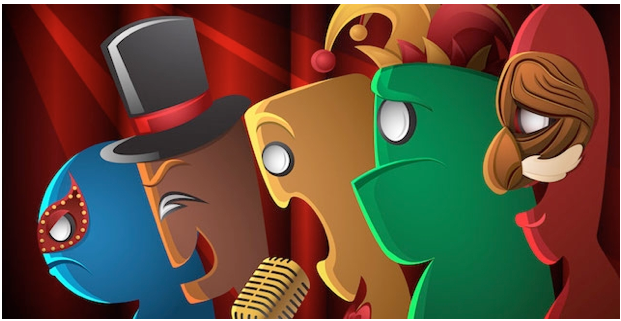CommentsGELFAND’S WORLD--The Hollywood Fringe hosts nearly three hundred theatrical performances in the month of June. It describes itself as an annual, open-access, community-derived event celebrating freedom of expression and collaboration in the performing arts. That makes for plays, comedy acts, songs, and the odd magician or two, with allowance for nudity, political radicalism, occasional sanctimony, and lots of experimental writing. The catalog (see the link above) gives fair warning as to productions that push the envelope.
The way to experience the Fringe is to show up on the day of your liking and take in two, three, or four performances and finish at the bar in Fringe Central. To make this approach possible, the Fringe encourages its productions to keep ticket prices low, typically in the five to fifteen dollar range. You might think of an afternoon and evening at the Fringe as ATM-accessible.
Since the Fringe is open-access, that means that the piece you start out with may be dull, but sixty minutes later you may find yourself at a production that comes alive. My pick so far is the peculiarly named Bumperstickers the musical. The concept seems a little strange at first -- think of all those bumperstickers and build a musical with a heart around them -- but this group makes it work. They throw in some witty words and some pretty good tunes (music and lyrics by Gary Stockdale), and let rip. The organizers did a crowd funding campaign through Indiegogo and, I've got to assume, that contributed to the full house on opening night.
The plot, such as it is, is hung around 9 cast members who are sitting in traffic on the freeway during a typically jammed LA morning, listening to the radio and every once in a while noticing a bumper sticker. The bumper stickers are ones we remember, signifying the various social, political, and religious attachments automobile drivers wished to communicate to each other, ranging from the assertive (God said it, I believe it, that settles it) to the more embracing (coexist). Each such sticker provides the jumping-off point for a song-and-dance number. Using this conceit, the script allows itself to explore our modern society in ways alternately comedic and touching.
Saturday night's show had a full audience who clapped along, tapped their feet, and cheered the actors. Performances of note were contributed by Jennifer Leigh Warren, who performed a gospel number expertly, Eliot Hochberg, who brings life to the role of the truck driver exhibiting the notorious old bumpersticker Gas, Grass, or Ass, Nobody Rides for Free, opera singer Jahmaul Bakare who makes fun of My Other Car is a Porsche, and Zachary Ford as the various radio announcers we listen to during rush hour. Lamont Dozier Jr. brought new life to the "I heart" bumper stickers we've grown to hate, and the remainder of a cast filled by talented professionals made for an enjoyable 90 minutes.
On the same Saturday afternoon, I saw magician Nick Paul, who explains that he performs at the Magic Castle and cruise ships, and who does something tricky and a little scary when he pulls a giant inflated balloon over his head during a card trick. I also wandered into Vincent Deconstructed, nominally a play about Van Gogh near the end of his short life, and approximately at the level of a college drama society performance. There was overacting characterized by gasps and pained pauses, and some credible Italian accents. To adapt an old line, the characters were given too many words, all assembled in literary style in grammatically correct, complete sentences. People don't talk like that in any century.
I'm looking forward to a production of The Owl and the Pussycat directed by friend and colleague Todd Felderstein.
Summer Shakespeare and something almost about Shakespeare
Tom Stoppard created his magnificent comedy/tragedy/satire Rosencrantz and Guildenstern are Dead in the 1960s. Coincidentally, it was first performed at the greatest of Fringe festivals in Edinburgh in 1966. This summer, we are lucky to have it back, in Orange County at the American Coast Theater Company.
Rosencrantz and Guildenstern takes the titanic upheaval depicted in the play Hamlet and views it from the standpoint of two characters who are mere courtiers. How would ordinary people cope with the supra-human emotions -- and emoting -- of such as Ophelia, Hamlet, and Claudius? What do normal people feel in the presence of such an earthquake of feeling? Stoppard takes a shot at it with skill and humor.
The same company is alternating Stoppard's play with Hamlet, using the same cast. Hamlet is being directed by Jeremy Aluma, who directed a clown's version of Hamlet recently, as well as Lunatics and Actors, which excerpts parts of Hamlet as performed by mental patients. It will be interesting to see how Aluma interprets Hamlet as undiluted tragedy.
Finally, a list of nearly five dozen Shakespeare productions around town this summer can be found at the Shakespeare in LA website.
Addendum: Cell Phones
The recent report on cell phone radiation effects (or lack thereof) on rats has resulted in the usual hype. Careful analysis of the results can lead to various conclusions, ranging from the silly (cell phone radiation results in longer life on the average) to the concerned (cell phone radiation may result in cancer sometimes). Here is a careful analysis, albeit a long one, by cancer researcher David Gorski, who suggests that the design of the study and the results suggest that we are looking at false positives, that is to say, that the small number of tumors observed are chance results. There will be a lot of discussion of these results over the next few months, but the take-home lesson is likely to be that they are inconclusive.
(Bob Gelfand writes on science, politics, and culture for CityWatch. He can be reached at [email protected])
